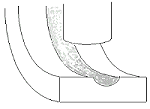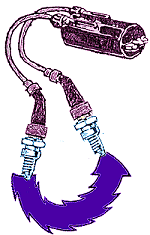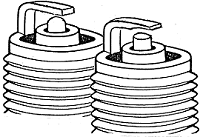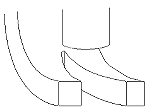  ® ®
|
Does the U-Gap Plug Really Do Anything?
|
 Honda SOHCs came from the factory with two brands of spark plugs: NGK and ND. Initially, the Nippon Denso plugs were junk. This was before the famous U-groove, and most mechanics felt that ND plugs fouled easily. In fact, they did. First, the plugs were coming in the motorcycles already fouled because Honda ran each machine before shipping it to the dealer. Since the bikes were run only to check for oil and vacuum leaks and to check shifting, they weren't operated long enough to get off the choke, Honda SOHCs came from the factory with two brands of spark plugs: NGK and ND. Initially, the Nippon Denso plugs were junk. This was before the famous U-groove, and most mechanics felt that ND plugs fouled easily. In fact, they did. First, the plugs were coming in the motorcycles already fouled because Honda ran each machine before shipping it to the dealer. Since the bikes were run only to check for oil and vacuum leaks and to check shifting, they weren't operated long enough to get off the choke,  and naturally, the plugs fouled. But soon it was discovered that this wasn't the primary source of the problem. Dealer mechanics found that replacement ND plugs also fouled. It turned out that the ND numbering system was slightly off. ND responded by revising its numbering (they essentially numbered all their plugs with the next colder number, i.e. the old X22 became the new X24, and the old X24 became the new X27), and to draw the public's attention to the improved product, they also introduced the U-groove technology. For the 1977 model season, new style (even the color of the plug's porcelain was changed) X22-U and X24-U plugs were shipped in about half the new Honda SOHCs, and mechanics found that ND plugs were a better product than they were before. Though NGKs were a proven quality and thus the plugs of choice for any wrench worth his dog-eared Snap-On tool catalog, ND's new sparkers began to acquire a following. and naturally, the plugs fouled. But soon it was discovered that this wasn't the primary source of the problem. Dealer mechanics found that replacement ND plugs also fouled. It turned out that the ND numbering system was slightly off. ND responded by revising its numbering (they essentially numbered all their plugs with the next colder number, i.e. the old X22 became the new X24, and the old X24 became the new X27), and to draw the public's attention to the improved product, they also introduced the U-groove technology. For the 1977 model season, new style (even the color of the plug's porcelain was changed) X22-U and X24-U plugs were shipped in about half the new Honda SOHCs, and mechanics found that ND plugs were a better product than they were before. Though NGKs were a proven quality and thus the plugs of choice for any wrench worth his dog-eared Snap-On tool catalog, ND's new sparkers began to acquire a following.
 But, other than being a marketing ploy for turning ND's spark plug sales around, the U-groove does in fact have a scientific purpose, though the benefit isn't exactly as advertised. With just two ignition coils firing the SOHC's four cylinders, each coil must fire two plugs, and this at the same time. This means that two of the bike's plugs fire forward—from the center electrode to the ground electrode, and two of them fire backward—from the ground electrode to the center electrode. You can verify this for yourself a number of ways. One is simply to look closely at plugs that have a lot of miles on them. The two forward firing ones will be worn mostly on their center electrodes, while the two reverse firing plugs will have most of the wear on the ground electrode. The reverse firing ones are harder to fire, because the spark is trying to jump from a blunt surface, and this results in a higher required firing voltage throughout the system overall (because each pair of plugs is wired in series). The U-groove design effectively makes both plugs fire from a But, other than being a marketing ploy for turning ND's spark plug sales around, the U-groove does in fact have a scientific purpose, though the benefit isn't exactly as advertised. With just two ignition coils firing the SOHC's four cylinders, each coil must fire two plugs, and this at the same time. This means that two of the bike's plugs fire forward—from the center electrode to the ground electrode, and two of them fire backward—from the ground electrode to the center electrode. You can verify this for yourself a number of ways. One is simply to look closely at plugs that have a lot of miles on them. The two forward firing ones will be worn mostly on their center electrodes, while the two reverse firing plugs will have most of the wear on the ground electrode. The reverse firing ones are harder to fire, because the spark is trying to jump from a blunt surface, and this results in a higher required firing voltage throughout the system overall (because each pair of plugs is wired in series). The U-groove design effectively makes both plugs fire from a  sharp surface, thereby lowering the system's voltage requirement, which results in improved ignition performance and longer plug life. The more recent Splitfire design operates on exactly the same principle, though its market target is the Harley crowd. Most carbureted Harleys also use waste spark type dual-output ignition coils. In fact, all motorcycles having half as many ignition coils as cylinders benefit from the the U-groove and Splitfire sharp edge technology. sharp surface, thereby lowering the system's voltage requirement, which results in improved ignition performance and longer plug life. The more recent Splitfire design operates on exactly the same principle, though its market target is the Harley crowd. Most carbureted Harleys also use waste spark type dual-output ignition coils. In fact, all motorcycles having half as many ignition coils as cylinders benefit from the the U-groove and Splitfire sharp edge technology.
Further Reading
Powersports Ignition Evolution
Resistor Plugs, Wires, and Related Issues
High Performance Ignition Coils
Optimizing the Honda SOHC Ignition
Honda DOHC, CBX Ignition System Troubleshooting
Reading Spark Plugs
GL1000 Ignition Tech
Email me
© 1996-2015 Mike Nixon
|
|